A mosaic novel, you say? What’s that when it’s at home? How’s it differ from a common or garden novel? Well, my favourite explanation is from the inimitable Jo Walton: “A normal novel tells a story by going straightforwardly at it, maybe with different points of view, maybe braided, but clearly going down one road of story. A mosaic novel builds up a picture of a world and a story obliquely, so that the whole is more than the sum of the parts.”
According to author Joe McDermott, the creation of a mosaic novel is based on a technique of fracturing one or more story elements: plot, theme, characters, and/or setting. One of these elements, however, should be kept intact to bind the various story threads together and keep the reader anchored in the tale as a whole. Each mosaic text tends to fracture differently, depending on the author’s preferences and the needs of the story. In a true mosaic the plot is always going to be fractured, with no central plotline and each story-tile following its own narrative thread that doesn’t lead to an ending that feeds in to a larger overarching story question. The links between the stories are found in recurring characters and settings, repeated story talismans, themes and motifs, and acts the consequences of which echo through subsequent tales in the mosaic.
Mosiac novels have been written by luminaries such as Nancy Kress, George R.R. Martin, Ray Bradbury, and Richard Bowes, to name but a few (I’ve even committed a few myself). But today I’m going to mention my five current favourites.
China Mountain Zhang by Maureen F. McHugh
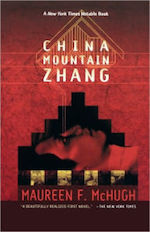 China Mountain Zhang won the Tiptree, Lambda Literary, and Locus Awards, and was nominated for both the Nebula and Hugo awards. It’s the mosaic novel Walton was referring to in the quote above, and it’s one of my favourites. The main story thread follows the life of Zhang Zhong Shan, a man with secrets to hide living an America that’s been utterly changed by a proletarian revolution, the Cleansing Winds Campaign—and basically become an outpost of China. Global warming has made large chunks of the U.S. uninhabitable, and part of the solution to this problem is the settlement of Mars.
China Mountain Zhang won the Tiptree, Lambda Literary, and Locus Awards, and was nominated for both the Nebula and Hugo awards. It’s the mosaic novel Walton was referring to in the quote above, and it’s one of my favourites. The main story thread follows the life of Zhang Zhong Shan, a man with secrets to hide living an America that’s been utterly changed by a proletarian revolution, the Cleansing Winds Campaign—and basically become an outpost of China. Global warming has made large chunks of the U.S. uninhabitable, and part of the solution to this problem is the settlement of Mars.
Zhang is the intersection of all the stories in this mosaic, being involved to varying degrees in with other characters’ lives. Sometimes we have Zhang’s own tale, other times we see him through the lens of another character’s life; these include Martine and Alexi, settlers trying to survive on Mars; Angel who indulges in the dangerous sport of a kite-racing above New York City; and San Xiang, the poster girl for “be careful of what you wish for or you might just get it” cautionary tales. Each character exists in a different part of the world McHugh has created for us, this strange, dangerous, disappointing Chinese-American dream, where everyone has secrets and lies to protect them—just to exist. China Mountain Zhang is a chilling, entrancing, encompassing view of a possible future.
Voice of the Fire by Alan Moore
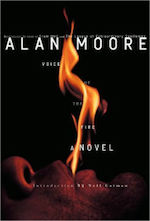 This is a challenging book and I don’t deny it, but it is worth persevering with. The twelve story-chapters form an imagined history of Moore’s birth city of Northampton across six thousand years, where characters recur in various tales and in various forms (first person narrator in one tale, a ghosts or death mask in another). The city is the constant anchor, with each chapter shifting narrator and time period, but using historical and cultural landmarks such as the cathedral and castle, as well as local legends like shagfoals as story talismans to show the reader a Northampton that they both do and do not know.
This is a challenging book and I don’t deny it, but it is worth persevering with. The twelve story-chapters form an imagined history of Moore’s birth city of Northampton across six thousand years, where characters recur in various tales and in various forms (first person narrator in one tale, a ghosts or death mask in another). The city is the constant anchor, with each chapter shifting narrator and time period, but using historical and cultural landmarks such as the cathedral and castle, as well as local legends like shagfoals as story talismans to show the reader a Northampton that they both do and do not know.
That bit I mentioned about a challenge? It’s the opening story, “Hob’s Hog.” The tale is hard to get through because its narrator is a Neolithic, intellectually challenged boy with a way of expressing himself that’s highly idiosyncratic, but it sets the scene for all that follows and the climax is stunning and disturbing and masterful. Other stories are truly astonishing, such as “The Cremation Fields” (in which a murderous young woman tries to lay claim to an inheritance not hers) and “I Travel in Suspenders” (a tale told by insurance fraud murderer A. A. Rouse).
City of Saints and Madmen by Jeff VanderMeer
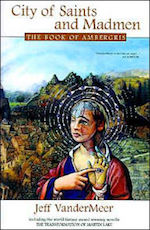 VanderMeer’s City is a magnificent achievement because it has the feel of the kind of document you’d find after the decline of a great civilisation; the sort of archival artefact that would help reconstruct an idea or an impression of a city—but one you’re never quite sure is accurate. City of Saints and Madmen stands as a kind of compendium history of Ambergris, linked by setting and the occasional recurrence of characters in various stories, and story talismans such as the street side saints, the Borges Bookshop, and the legendary figure of Voss Bender, composer and politician.
VanderMeer’s City is a magnificent achievement because it has the feel of the kind of document you’d find after the decline of a great civilisation; the sort of archival artefact that would help reconstruct an idea or an impression of a city—but one you’re never quite sure is accurate. City of Saints and Madmen stands as a kind of compendium history of Ambergris, linked by setting and the occasional recurrence of characters in various stories, and story talismans such as the street side saints, the Borges Bookshop, and the legendary figure of Voss Bender, composer and politician.
One of the unique elements of City of Saints and Madmen is that not all the stories are stories per se: one is a false bibliography, another a history of the famous Hoegbottom & Sons trading house intertwined with an early history of the city, yet another is a series of psychiatric case notes, while others stand as appendices. City of Saints and Madmen functions as a beautiful, fascinating faux historical text and reading it makes one feel like an archaeologist, stripping away the layers of a city’s past.
Accelerando by Charles Stross
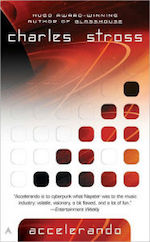 Accelerando is a mosaic saga split across three generations of one family as humanity expands beyond the stars after huge technological advancement. In telling a tale greater than the span of one human lifetime and one single location Stross is able to give a more varied and textured picture of the narrative world in which the characters play out their stories. The anchoring element is the narrator, an AI cat, Aineko, owned by successive family members, and the reader sees the various generational changes through the eyes of the animal. Accelerando won the 2006 Locus Award, as well as being nominated for the Hugo, Campbell, Clarke, and British Science Fiction Association Awards, and rightly so: it offers a vision of a world—a universe, really—vastly changed and virtually unrecognisable.
Accelerando is a mosaic saga split across three generations of one family as humanity expands beyond the stars after huge technological advancement. In telling a tale greater than the span of one human lifetime and one single location Stross is able to give a more varied and textured picture of the narrative world in which the characters play out their stories. The anchoring element is the narrator, an AI cat, Aineko, owned by successive family members, and the reader sees the various generational changes through the eyes of the animal. Accelerando won the 2006 Locus Award, as well as being nominated for the Hugo, Campbell, Clarke, and British Science Fiction Association Awards, and rightly so: it offers a vision of a world—a universe, really—vastly changed and virtually unrecognisable.
Central Station by Lavie Tidhar
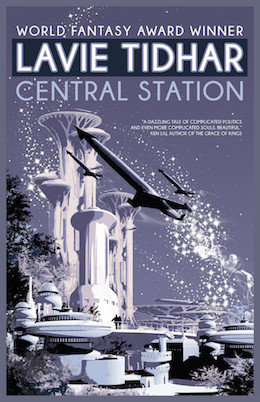 What better way to tell the tale of a diaspora—a dispersal, a scattering, a fracturing—than in a mosaic novel? Tidhar explores life, both virtual and real in this astonishing book: Mars has been colonised, space colonies are inextricably linked in dangerous ways, and earth is home to data-vampires, cyborg soldiers called robotniks, and strange children. This book is peopled by humans, machines, aliens, and everything in between. The space port is the hub where all the stories meet and mingle and here, as the cover blurb says, life is cheap, and data is cheaper. Central Station is vital and vigorous, challenging and mind-expanding, which of course might be said of any of Tidhar’s work, but with each new book he throws out a new challenge to himself and his readers. Blessed be the risk-takers, for they make our reading experiences incredible.
What better way to tell the tale of a diaspora—a dispersal, a scattering, a fracturing—than in a mosaic novel? Tidhar explores life, both virtual and real in this astonishing book: Mars has been colonised, space colonies are inextricably linked in dangerous ways, and earth is home to data-vampires, cyborg soldiers called robotniks, and strange children. This book is peopled by humans, machines, aliens, and everything in between. The space port is the hub where all the stories meet and mingle and here, as the cover blurb says, life is cheap, and data is cheaper. Central Station is vital and vigorous, challenging and mind-expanding, which of course might be said of any of Tidhar’s work, but with each new book he throws out a new challenge to himself and his readers. Blessed be the risk-takers, for they make our reading experiences incredible.
In short, each story in a mosaic novel should be able to stand on its own, but reading them in isolation is rather like looking at one strand of a spider’s web: it won’t give you a true idea about the shape of the entire construct. The connections between these tales are often imperceptible until revealed in the light shed by another story in the mosaic, and the depth of meaning obscured until subsequent tales are read, and then the undercurrents and layers of what’s gone before become clear, making the experience richer and more textured.
 Angela Slatter is the author of eight short story collections, including The Girl with No Hands and Other Tales, Sourdough and Other Stories, The Bitterwood Bible and Other Recountings, and A Feast of Sorrows. Angela has won a World Fantasy Award, a British Fantasy Award, one Ditmar Award, and five Aurealis Awards. She has an MA and a PhD in Creative Writing, is a graduate of Clarion South and the Tin House Summer Writers Workshop. She was an inaugural Queensland Writers Fellow in 2013, and the Established Writer-in-Residence at the Katharine Susannah Prichard Writers Centre in Perth in 2016. Her debut novel, Vigil, was released by Jo Fletcher Books (Quercus/Hachette) in July 2016, and the sequels, Corpselight and Restoration will follow in 2017 and 2018 respectively.
Angela Slatter is the author of eight short story collections, including The Girl with No Hands and Other Tales, Sourdough and Other Stories, The Bitterwood Bible and Other Recountings, and A Feast of Sorrows. Angela has won a World Fantasy Award, a British Fantasy Award, one Ditmar Award, and five Aurealis Awards. She has an MA and a PhD in Creative Writing, is a graduate of Clarion South and the Tin House Summer Writers Workshop. She was an inaugural Queensland Writers Fellow in 2013, and the Established Writer-in-Residence at the Katharine Susannah Prichard Writers Centre in Perth in 2016. Her debut novel, Vigil, was released by Jo Fletcher Books (Quercus/Hachette) in July 2016, and the sequels, Corpselight and Restoration will follow in 2017 and 2018 respectively.










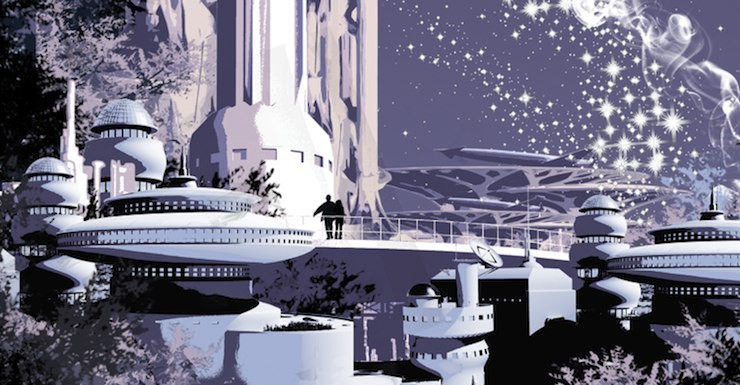
Didn’t like Accelerando and haven’t read the rest, but my goodness that Central Station cover is beautiful. I for sure would have picked it up had I seen it in the book store.
I have Accelerando for my Kobo – haven’t got to it yet. Know nothing about the rest though.
I always liked Number 9 Dream by David Mitchell
Love China Mountain Zhang, Central Station and City of Saints and Madmen. Didn’t like Accelerando and haven’t read the Alan Moore.
Picked up the bug for these back when Thieves World was new. Can’t really believe that I’m still reading new Wild Cards books after all these years.
Finally, a pithy description for Always Coming Home!
I have to be a little skeptical of an essay about mosaic novels that doesn’t so much as mention the Wild Cards series, which was the SF genre’s self-labeled prototype of the form. I will grant that the OED-derived definition given in Jeff Prucher’s Brave New Words doesn’t require mosaic novels to be collaborative works (as is the case with most of the Wild Cards books), but I’d argue that the form is one which is uniquely suited to and arguably enhanced by collaborative composition.
I would also be cautious about labeling any work of composite fiction a “mosaic novel”. I have not read the VanderMeer work noted above, but the specific description given reminds me strongly of Le Guin’s Always Coming Home. I think I’d argue that both of those are something other than novels, at least in the structural and narrative sense by which students of literature understand that word. Let me be clear here: I’m not attempting to evaluate the literary quality of either the Le Guin work or the VanderMeer in making this statement, particularly since I’ve only read one of the two. I’m merely suggesting that the classification of either work as a “novel” may be open to question.
ETA: Crossposted with #6, and as noted, I’d disagree with the characterization.
@7: If Wild Cards claimed to be the prototype, it was mistaken. The Liavek books, which have just as much interaction between stories, started two years before; one can even make a case for Thieves World several years before Liavek, although the connections between stories were weaker. But the first genre novel to deliberately imitate Dos Passos’s U.S.A. (sometimes called the first mosaic novel) is Stand on Zanzibar (Brunner, 1968), which uses not just overlapping stories but complementary modes/granularities, from mainline plot through sidebar stories to “source” blockquotes and 60-second newscasts. Present-day readers may bridle at some of the sexism, but the politics and many of the people still ring true.
Feersum Endjiin by Ian M. Banks has got to be on this list. Anyone interested in digging deeper into the language of narrative should read Mieke Bal’s comprehensive theory of narrative in Narratology. While I can appreciate the use of the term mosiac here, it falls somewhat short of doing justice to the literary device.
Don’t forget the Master of the Mosaic, Ian MacDonald.
Any of Emily St John Mandel’s novelswould qualify. Station Eleven is the SFF example but I recently read The Singer’s Gun – wonderfully interleaved stories.
#8: There are several interlocking matters to untangle here.
First, per Brave New Words, the Wild Cards books were the first SF publications to refer to themselves as “mosaic novels” rather than “shared world anthologies”. Neither Thieves’ World nor Liavek nor Merovingian Nights (about which more in a moment) ever billed themselves as mosaic works. [As it happens, this is a subject on which I have a degree of specialized background; I was actively reviewing SF/F for Dragon magazine during that period, and shared-world fiction was one of my areas of particular interest. Amusingly, this is also documented in Strange New Words — the two earliest citations given for the term “shared world” relative to genre work are, in fact, from those columns, the first dating from late 1985, and nothing prior has yet been submitted to the Web site from which Brave New Words was largely compiled.]
Now we get into more interesting territory. It’s fairly well-settled, I think, that Thieves’ World was the first shared-world anthology to appear in the modern SF/F genre (although the Encyclopedia of Fantasy says that the earliest recognizable examples appear in British Christmas annuals from the 1860s). And yes, Liavek (1985-1990) and Merovingian Nights (1987-1991) both also at least antedate Wild Cards (for the present purpose, I’m not counting Angel with the Sword, the C. J. Cherryh novel from which the latter anthology series arose, as part of the shared canon).
But just as I argued in my earlier post that I don’t think Always Coming Home is a mosaic novel, I’d argue that the phrases “shared world anthology” and “mosaic novel” are not one-to-one equivalents. I think we’d agree that Thieves’ World in particular doesn’t qualify, and I am not sure I’d count any of the Liavek volumes either, as much as I liked that series. Liavek is a well-crafted and unique world, but I think its component books are best viewed as excellent anthologies rather than novels sewn together Frankenstein-fashion.
I am a little less certain where I’d put Merovingian Nights. This is in significant part because it’s been a good deal longer since I’ve looked at those than is the case with the Liavek canon (not least because I don’t presently have that series to hand, it having been sacrificed some while back in one of the regrettable but necessary rounds of pruning performed by apartment-dwelling bibliophiles). I distinctly recall individual books in that series having identifiable novel-like plot arcs — and also that the song lyrics some of the writers contributed acted as refractions of incidents occurring elsewhere in the texts.
Now to be strictly fair, it’s also been a looong time since I’ve looked at that first Wild Cards book, and I didn’t take to the series nearly as well as I took to some of the others I’ve mentioned. So to a non-trivial degree, I’m taking those books’ self-identification at their word when I refer to them as mosaic novels. If/when I next reread one of those volumes, I’ll have to keep that in mind.
OTOH, just to complicate the exercise a touch further, I am in fact presently about 3/4 of the way through a book that I can’t call anything but a mosaic novel, in which five different authors have each contributed independent work that, presented together, is telling a discernibly larger story that’s greater than the sum of any of the parts. That book is Monstrous Little Voices, from Abaddon, and besides being unequivocally mosaic in nature, it’s also one of the most fascinating re-imaginings of Shakespearean canon I’ve ever run across. (And I am picky about my Shakespearean riffs.) I reserve the right to come back later and tell you that it all fell apart in the last section, but at this point I very much doubt I’ll be so inclined.
@12: We could argue endlessly over just how much arc there is or isn’t in each of the series you name (and I find it interesting that all of them \are/ series rather than individual books); I’d grant that Thieves World is probably lower on the scale, but consider (for instance) the arc of The Magician over the Liavek books — which certainly do give us a story from several aspects (especially if you include Ford’s Casting Fortune, which contains a story that touches on several others but was too long for any of the multi-author books). I’d love to know how much of the Wild Cards formatting, which sometimes breaks up one author’s story into pieces interlaced with other stories, was intended by the authors and how much was imposed by the editors as a way of forcing lightly-related pieces together.
But I think that under Angela’s terms (which don’t require multiple authors) Brunner stands decades in advance of any of them. I grant that it is less subtle in its tiling than her examples, since it explicitly tells you what kind of tile you’re reading — but that is also true of Dos Passos (from what I read — I haven’t tried the work itself).
#13: Certainly Brunner’s material would long precede Wild Cards, or any of the other collaborative shared worlds. I should probably have been more explicit about this earlier; it’s never been my own position either that Wild Cards was the first mosaic novel to appear in-genre — or for that matter, that the Wild Cards creators thought that it was. I’m pointing out simply that it was the first to openly label itself as such. Wikipedia mentions Wilkie Collins’ The Moonstone as another primary example, which would be a great deal earlier than the Dos Passos trilogy.
As to the Magician’s arc in Liavek: hmm. My observation there is that yes, there’s a noteworthy character arc there…but as I look at the idea of “novel” (as distinguished from “mosaic novel”), I don’t think that arc is so central to any one volume of the series as to make any of those books — or even the series as a whole — a mosaic novel. Monstrous Little Voices, on the other hand — which I’ve now finished — seems to me to have a novel-shaped framework underneath it that I think distinguishes it from any of the shared-world series I’ve described upstream. Mind, I think Shakespeare buffs will be arguing about Jonathan Barnes’ capstone section for a long while to come, but that’s one of the things that makes that book as fascinating as it is.
My own favorite novel of this type is “Stand on Zanzibar” by John Brunner.
Definitely keen to read 1 or 2 of these, Central Station and Voices of the Fire especially. I would add Cloud Atlas and, If on a winter’s night a traveler.
“If on a winter’s night a traveler” by Italo Calvino and “The Orphan’s Tale”, a two book novel by Catherynne Valente. Both authors write beautifully poetic phrases. Also, I’m a big fan of Charles Stross (especially the laundry novels) but I could not get into Accelerando.
The Carpet Makers by Andreas Eschbach (https://www.goodreads.com/book/show/171125.The_Carpet_Makers) should be on the list.